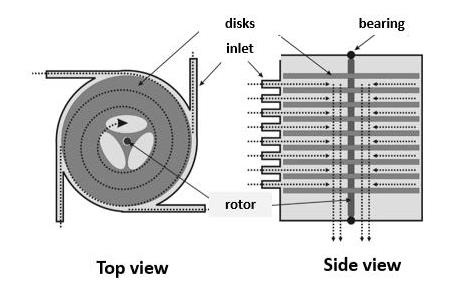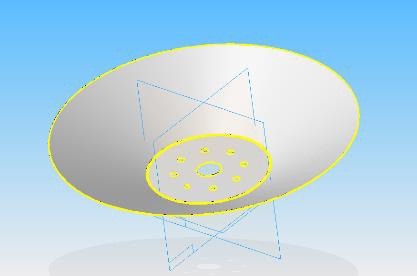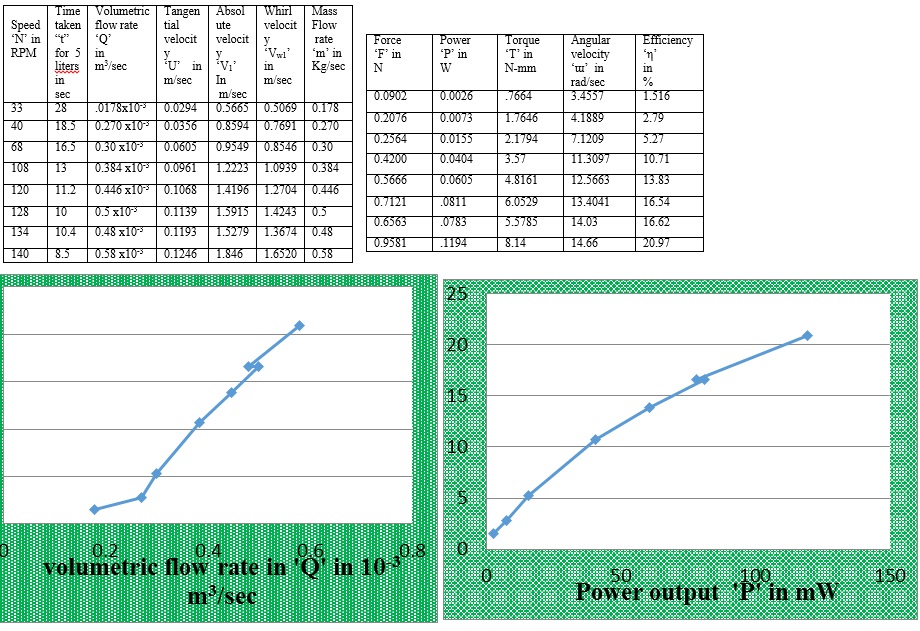





Published on Nov 30, 2023
In this paper a water turbine is designed and fabricated based on the ideals of Tesla’s turbine. In remote places due to frequent power cuts the alternate source of energy for house hold power requirements is very essential. Also, it is necessary that this source should be portable and easily operated by common man. The purpose of this work is to design and fabricate a portable water turbine using the principle of Tesla turbine. The main aim of this turbine is to utilize the potential and kinetic energy of a conventional water supply. Appropriate changes are made in the existing plate, shaft and nozzle design with respect to the literature survey. This paper includes design and fabrication of portable water turbine along with necessary results and calculations
Tesla’s turbine is a bladeless turbine which uses series of rotating discs to covert fluid flow energy into mechanical energy .This turbine is popularly known has Tesla’s turbine patented in the year 1913 by Serbian mechanical and electrical engineer Nikola Tesla. A Tesla turbine consists of a set of smooth disks, with nozzles applying a moving fluid to the edge of the disk. The fluid drags on the disk by means of viscosity and the adhesion of the surface layer of the fluid. As the fluid slows and adds energy to the disks, it spirals into the center exhaust. Since the rotor has no projections, it is very sturdy. The Tesla turbine has the trait of being in an installation normally working with a mixture of steam and products of combustion and in which the exhaust heat is used to provide steam which is supplied to the turbine, providing a valve governing the supply of the steam so that the pressures and temperatures can be adjusted to the optimum working conditions.
The reason for selecting this turbine is its simplicity in the design and concept. The impact of water on the plates exerts a centripetal boundary layer effect causing its rotation .The water creates vortex inside the casing escaping through the centre of the plate and out of the turbine. This turbine is so versatile that it can be used for multiple applications. Since the design by Tesla is highly efficient. This turbine is very much stable at high rotating speeds.

Fig -1 Front and top view of Tesla’s turbine
There are large variety of turbines currently in the market that are very expensive and efficient but very seldom are economic and effective for low heads. If a turbine can generate a medium amount of power on a regular basis produced by a low head it would provide significant help to people living in remote places. The purpose of this project is to design and fabricate low head water turbine based on Tesla’s turbine design.
Based on Tesla’s model modifications are planned to the design to improve the efficiency. The modifications planned so that the turbine is made suitable for low head applications. The changes are made in the blade design to help reduce the losses during the exit of the water from the plates and also the exhaust outside the housing.
The design constraints were all analysed by studying the literature survey carefully and choosing the best possible design for the most efficient outcomes for the required low head applications.
• Plates
• Shaft
• Bearings
• Housing
• Nozzle
The design constraints are obtained from the research papers studied. All the necessary design constraints are as shown in the above table, as per the constraints required calculations are made. Each of the major parts are designed using SOLIDEDGE V18 with all the calculations made . The calculations made for the parts and 2D & 3D view of the components are shown in the next section.
Based on the available thickness (t) of the sheet metal which was 0.4x10-3m the specifications were calculated. Therefore, t=0.4x10-3m.
The inter-disk spacing(b) based on the thickness is calculated using the relation, t< b/2. Therefore, b is found to be 0.8x10-3m.
The design of the plates is mostly based on the thickness of the plates. According to the literature it was found the R3-N3 design was best suited for low head applications. Due to fabrication constraints the least thickness (t) that could be used was 0.4mm stainless steel sheet metal. The use of stainless steel was due to its corrosion resistant properties as we were using it for water applications.
The interdisk spacing(b) was calculated using the relation t<b/2 and was found to be 0.8mm.
Aspect ratio (є): b/ro <0.01, using which ‘ro’ was calculated to be 80mm but we took 100mm for more surface area .
Radius ratio (єi): 0.3< ri/ro<0.4, using this relation ‘ri’ was found to be 0.04m.
With respect to the nozzle entry angle the bend that could be introduced onto the plates was found to 26.5°. This relation was assumed by taking the geometric relation of interior alternate angles between the coinciding axis between the two parameters.
Distance between center of ‘ri’ and center ‘ro’ is 15mm.
Cone calculation for the process of fabrication was found from the relation, θ = (r/s)*360 in which r signifies ro and s the slant angle of the cone drawn at 26.5 degrees.
Height of the plates was calculated to be 32.4mm.
The shaft hole that was assumed was 18mm.
The first plate was to be made with the exit hole whereas the rest of the 12 plates required holes for the exit of the water.

The design of water turbine is studied and fabrication process is planned based on design constraints and the available materials, machining processes and equipment’s. The water turbine parts are fabricated and all the parts are assembled.
Material used :- stainless steel 304 sheet metal of 0.4 mm thickness
The plates are cut as per the cone calculations using the relation θ = r/s*360
Tungsten inert gas (TIG) welding is used for joining the sheet metal so as to obtain desired plate design .
Araldite is applied for the plates to obtain strength
Material used :- Aluminium 6061
The material procured is turned as per the required dimension using Lathe
Material used ,
Aluminium of thickness 10mm for cylinder
Aluminium of thickness 16mm for cover plates
10mm thickness Al is rolled to obtain a cylindrical shape and is joined by arc welding process.
The bottom cover plate is bored to place bearing and the holes are drilled as per the design is joined by means of arc welding.
The top cover plate also is bored as per bearing dimension to fit the bearing.

The turbine was designed and fabricated as per the calculations made from the literature. The obtained results were tabulated and graphs were made to show the variation of different parameters.

• Turbine performance can be improved by introducing flow directors.
• Improving design of housing.
• Add another nozzle to improve the stability.
• Add magnetic bearing to reduce rolling friction.
• Incorporating better design for exhaust of water.
• Use of lighter material for housing like epoxy resin will reduce overall weight of the turbine.
• Shape of shaft and also be changed to minimize rotational losses.
By understanding the working principle of the Tesla turbine, the available design is modified with respect to various parameters and fabrication is done. As the water flows into the gap within the plates, the velocity keeps dropping throughout the flow till the exit. As the maximum loss in the blades is due to the axial exit of the water this loss is overcome by changing the design of the plates. Introducing a bend of 26.5° which is related to the angle made by the nozzle, this bend provides a more uniform exit of the water without hampering the rotation of the plates.
The turbine can be used in remote locations where there is shortage or no supply of electricity. It can also be used to regenerate the lost power in pumps. It is also a major advantage for various domestic applications. Since it is portable it can be carried easily and used where a source of water is available to generate power.
[1] B. P. Ho-Yan, "Tesla Turbine for Pico Hydro Applications" Guelph Engineering Journal, vol. 4, pp. 1-8, 2011.
[2] R. W. Lawn M. J, "Calculated Design Data for the Multiple-Disk Turbine using Incompressible Fluid," Journal of Fluids Engineering, Transactions of the ASME, vol. 96, no. 3, pp. 252-258, 1974.
[3] G. A. Hoya G. P, "The design of a test rig and study of the performance and efficiency of a Tesla disc turbine," Proceedings of the Institution of Mechanical Engineers, Part A: Journal of Power and Energy, vol. 223, pp. 451-465, 2009.
[4] R. C. North, "An Investigation of the Tesla Turbine," Mechanical Engineering, University of Maryland, 1969.